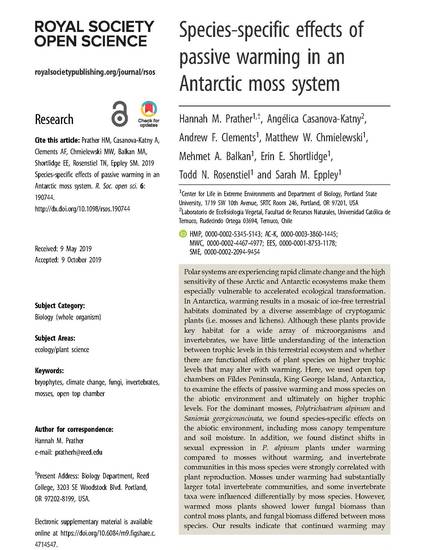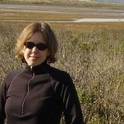
- Micro-arthropods,
- Mosses -- Antarctica,
- Temperature Increases
Polar systems are experiencing rapid climate change and the high sensitivity of these Arctic and Antarctic ecosystems make them especially vulnerable to accelerated ecological transformation. In Antarctica, warming results in a mosaic of ice-free terrestrial habitats dominated by a diverse assemblage of cryptogamic plants (i.e. mosses and lichens). Although these plants provide key habitat for a wide array of microorganisms and invertebrates, we have little understanding of the interaction between trophic levels in this terrestrial ecosystem and whether there are functional effects of plant species on higher trophic levels that may alter with warming. Here, we used open top chambers on Fildes Peninsula, King George Island, Antarctica, to examine the effects of passive warming and moss species on the abiotic environment and ultimately on higher trophic levels. For the dominant mosses, Polytrichastrum alpinum and Sanionia georgicouncinata, we found species-specific effects on the abiotic environment, including moss canopy temperature and soil moisture. In addition, we found distinct shifts in sexual expression in P. alpinum plants under warming compared to mosses without warming, and invertebrate communities in this moss species were strongly correlated with plant reproduction. Mosses under warming had substantially larger total invertebrate communities, and some invertebrate taxa were influenced differentially by moss species. However, warmed moss plants showed lower fungal biomass than control moss plants, and fungal biomass differed between moss species. Our results indicate that continued warming may impact the reproductive output of Antarctic moss species, potentially altering terrestrial ecosystems dynamics from the bottom up. Understanding these effects requires clarifying the foundational, mechanistic role that individual plant species play in mediating complex interactions in Antarctica's terrestrial food webs.

© 2019 The Authors. Published by the Royal Society under the terms of the Creative Commons Attribution License http://creativecommons.org/licenses/by/4.0/, which permits unrestricted use, provided the original author and source are credited.